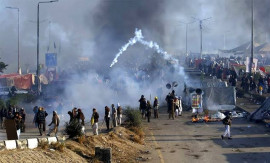
My favourite study in social anthropology is the story of Pir Balanosh — demon eater — from Chagai district in Balochistan. As recorded by G P Tate in The Frontiers of Baluchistan (1909), there lived in the hills north of Dalbandin town a green dragon that ate a human every day. Wearying of this terrible toll, the people petitioned a man of God to deliver them of their bane. A great struggle ensued; the saint destroyed the dragon and won the respect of the local Baloch. After he died, his tomb became a much visited shrine. And so it remains to this day.
I visited the shrine in November 2007 and in the century intervening between Tate and me, the narrative had changed completely. Dragons being old hat, Pir Balanosh had defeated Sajadeen, the ‘roosi sadr’ (Russian president!), so the story now went. Infidels, being necessarily evil, this fiend did not eat humans. Instead, he took one virgin daily to his bedchamber.
Then a local man travelled to distant Makran where Pir Balanosh lived and asked him for his help. The saint arrived and using his miraculous powers to paralyse the infidel army, destroyed Sajadeen and his horde. The open-to-the-sky tomb had a plaque that placed this saint in or about the year 1494 of the Common Era. By a very fanciful genealogy that gave each generation a lifespan of a century-and-a-half, the saint was made a grandson of Abdul Qadir Jilani.
This evidently was the narrative that developed from the ingress of Afghan refugees following the Soviet invasion of their country in 1979. Surely some of those newcomers would have told tales (not necessarily true) of the communists’ propensity for virgins coupled with the new and upcoming ‘Islam against the rest of the world’ mentality. There may have been a name or two to go with the yarns but despite serious quizzing, it was impossible to get to the root of the name Sajadeen. I was tempted to believe it was a corruption of Stalin, but it was naive to believe that the illiterate keeper of the shrine would have ever heard of this bygone communist elder.
The Chagai District Gazetteer of 1906, records that at some indeterminate time in the past, a family of so-called Syeds settled around Chagai. Not long afterwards, Baloch of the Sanjrani sub-tribe, having attacked them, expelled them after considerable slaughter. The Syeds fled to the area where the shrine of Balanosh now stands, while the Sanjranis took up abode around Chagai.
The gazetteer assigns no cause to this battle, but this may well have been an early water war of which we will in the near future see many more. Chagai, whose name signifies ‘place of wells’ (chah being a well in Persian and its derivative Balochi), was known for its several wells in an otherwise utterly desiccated land. The wandering Sanjranis, having arrived here with their livestock, may not have been welcomed by the Syeds. Warlike and sufficiently flamboyant to not care a whit for people who claimed holy descent, the Baloch ousted the earlier inhabitants and took up abode in Chagai.
To mask their humiliation at the hands of the Baloch, the discomfited Syeds invented the story of having been invited here to deliver the former of the man-eating dragon. Over the years, the battle was only vaguely remembered and even the Baloch began to celebrate the local version of St George. Indeed, the newish plaque on the tomb of Balanosh bears the name of a Sanjrani follower.
That was the past when communication was slow and legends easily took root in isolated places. What is truly strange is that the modern legend of Sajadeen and his kafirs was born. Even more peculiar is the fact that this legend not just replaced the earlier one within a few years of the ingress of Afghan refugees, but that it became completely socially ingrained.
In November 2007, when I was there, nobody, not even the keeper of the shrine (claiming descent from Balanosh), remembered the old yarn. Despite repeated attempts to refresh his memory regarding the dragon-slaying credentials of his fictitious ancestor, the fifty-year-old man steadfastly refused to concede that such a story had ever existed.
Published in The Express Tribune, May 28th, 2011.






















1713350999-0/Tribune-Collage-Feature-Images-(5)1713350999-0-270x192.webp)

1713348933-0/BeFunky-collage-(3)1713348933-0-270x192.webp)





















COMMENTS (5)
Comments are moderated and generally will be posted if they are on-topic and not abusive.
For more information, please see our Comments FAQ